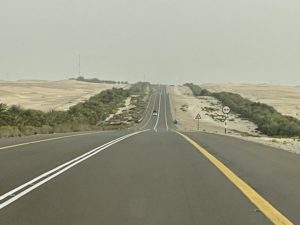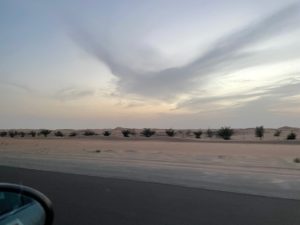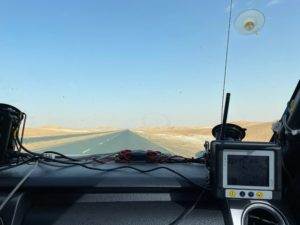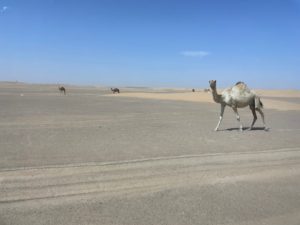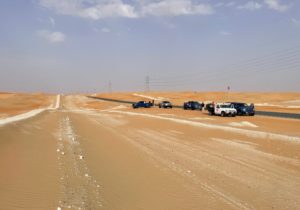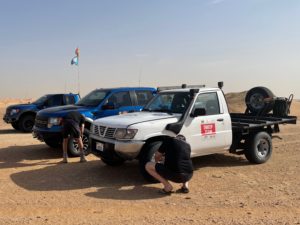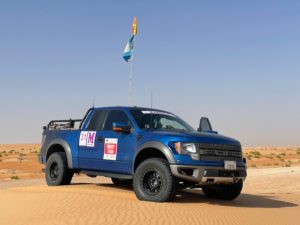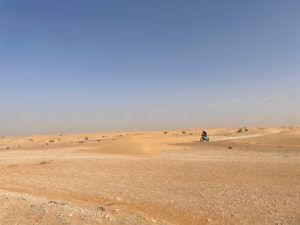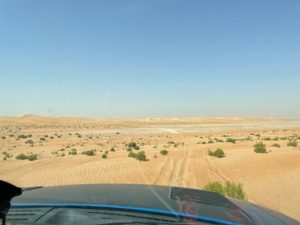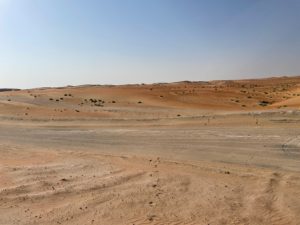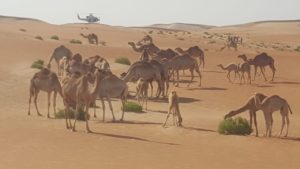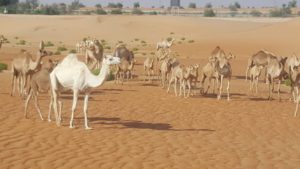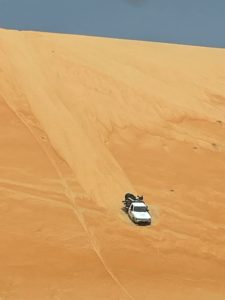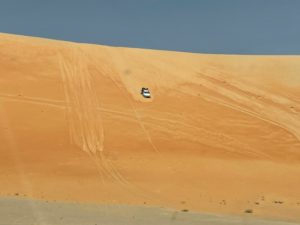In which Sid learns about extreme off-roading and rescue, often self rescue…
Each morning Sweep Two will go out to the first control point that can be reached mainly by road. We will wait somewhere with a view over the route, drop our tyre pressures and once 25 bikes have gone past the two Raptors and the Nissan will rumble off along the rally route ready to be deployed or finding people needing help.
On our first morning we leave Abu Dhabi down a dead straight road south towards the Saudi border. The whole country is about the size of Maine but still has plenty of emptiness. More roads are being built, very often formalising gatch tracks (nearest European equivalent term is “piste roads”) and old truck routes through the desert. It is normal to see roads being swept of sand as the desert relentlessly reclaims tarmac, fences and buildings. The desert roads can often be straight, because there are no river valleys.
Camels are a zoo animal in Europe and the US, but here they roam freely and are kept for milk, meat, racing, and beauty contests (yes really). Camels are often kept behind fences but once we are off the road our route will go through those fenced and unfenced areas and in many places the fence has already been buried by sand so you can just walk over the top of it. Where there are fences and gates there are sometimes grids too.
Where the rally raid route crosses a pipeline, which is usually just shallowly buried in the sand with warning sights, there will often be a control to make sure competitors are not pounding over the pipeline but going where the pipeline is deeply buried. The Abu Dhabi National Oil Company really does not like people damaging the pipes. The organisers can see where competitors and officials have transgressed, and it makes them very cross because they have to repair the pipeline afterwards.
Here is a control. For some distance before and after the control vehicles obey a speed limit within a perimeter signalled by the squealing comms on their bike or car. The cunning biker will put a rear wheel on the tarmac to get up to pit-lane speed quickly.
Once on the sand the sweep drivers drop their tyre pressures. Too low and they come off the rim. Not low enough and there is insufficient traction. About 15 to 18 psi seemed to be the rule. The white Patrol pick-up is the Emirates Motor Sport Organisation’s own ‘toast rack’ so called because of the way the flat bed is laid out to carry three or four bikes across the width of the bed. The Raptor is Paul’s short wheel base version – just a great picture (though he does carry a white rose of Yorkshire flag).
Not all desert is sand. The harder surface seen here is much easier for making progress. The rally route is set out by John Spiller (ex nav to Saeed Al Hajri, known to the Irish as Sid Hedgerow, and Subaru team manager) driving his normal-ish Nissan Patrol and seeking out a challenging route. About 300 kilometres per day. We can see the original Spiller route on our Garmin but the rally route on the day is really set by the first bikes, then the rest follow those tracks. If the first one goes wrong, they all go wrong.
 Inside the SweepMobile this is what our ‘rear gunner’ can see, and we must keep a keen lookout because the rally cars are approaching very very fast behind us. Although the comms should set off a shrieker to warn us of incoming, in practice this mirror (with warning text at the bottom “remember, vehicles may be closer than they appear in the mirror”) is often our only warning when the rear car radios the rest of the team.
Inside the SweepMobile this is what our ‘rear gunner’ can see, and we must keep a keen lookout because the rally cars are approaching very very fast behind us. Although the comms should set off a shrieker to warn us of incoming, in practice this mirror (with warning text at the bottom “remember, vehicles may be closer than they appear in the mirror”) is often our only warning when the rear car radios the rest of the team.
 Even the best people get stuck. The longer Raptor was more prone to getting crested, partly because Ian was leading and wanting to get a look down the other side of a dune before committing. Once he/we were over the others could follow confidently. In the first couple of hours Sid re-acclimatised to the angles involved. At the top of a dune it can look like a vertical drop. In fact the slump angle of sand is under 40 degrees. In the car it feels much, much more more. Sid’s toes uncurled after the first two millennia.
Even the best people get stuck. The longer Raptor was more prone to getting crested, partly because Ian was leading and wanting to get a look down the other side of a dune before committing. Once he/we were over the others could follow confidently. In the first couple of hours Sid re-acclimatised to the angles involved. At the top of a dune it can look like a vertical drop. In fact the slump angle of sand is under 40 degrees. In the car it feels much, much more more. Sid’s toes uncurled after the first two millennia.
 After one crest and rescue a front tyre came off Ian’s car. In this picture Sid has toiled up to the the top of a dune to wave rally traffic away from the work below. The high jack has a big base so it doesn’t sink. The tyre did pop back on but we found that crushing the front axle into the top of a dune had smashed the front crown wheel. This meant rear wheel drive only, and four wheel drive is pretty essential on this terrain, so Matt and Paul scouted an ‘easy’ route to a gatch track. That night we transferred all the nav and comms kit to Paul’s car so we could carry while Ian’s car stuck to the grippy surfaces.
After one crest and rescue a front tyre came off Ian’s car. In this picture Sid has toiled up to the the top of a dune to wave rally traffic away from the work below. The high jack has a big base so it doesn’t sink. The tyre did pop back on but we found that crushing the front axle into the top of a dune had smashed the front crown wheel. This meant rear wheel drive only, and four wheel drive is pretty essential on this terrain, so Matt and Paul scouted an ‘easy’ route to a gatch track. That night we transferred all the nav and comms kit to Paul’s car so we could carry while Ian’s car stuck to the grippy surfaces.
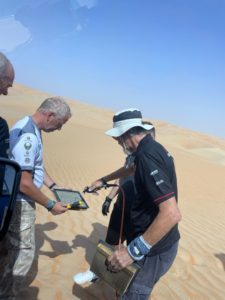 Dune bashing raises clouds of sand that the 400 bhp, 6.2 litre Raptor engine tries to suck in. Here the air filters are being blown out with an airline from our on-board compressor. Power was well down and it was Juan, our FIA guest from Peru’s ASN, who suggested checking the filters. We have an invitation to work as sweeps on the Rally of the Incas. We could.
Dune bashing raises clouds of sand that the 400 bhp, 6.2 litre Raptor engine tries to suck in. Here the air filters are being blown out with an airline from our on-board compressor. Power was well down and it was Juan, our FIA guest from Peru’s ASN, who suggested checking the filters. We have an invitation to work as sweeps on the Rally of the Incas. We could.
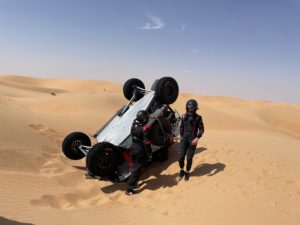 Just as we had unstuck ourselves from a problem of our own this Czech crew managed to trip their CanAm buggy. Sweep Two radioed the problem in and then pulled them back over. Further work for the winch was to drag the front of the car straight and off the radiator. The crew got back to the bivvy and were out again the next day. On this one we had time to take a picture.
Just as we had unstuck ourselves from a problem of our own this Czech crew managed to trip their CanAm buggy. Sweep Two radioed the problem in and then pulled them back over. Further work for the winch was to drag the front of the car straight and off the radiator. The crew got back to the bivvy and were out again the next day. On this one we had time to take a picture.
Our other top episodes were coming across one of the Czech trucks stuck up a dune in second gear. The two Raptors had winches with Dyneema rope and were able to pull the truck back so it could turn around. We then found them a route out of the dunes, from where they could go slowly back to the service area.
Perhaps our favourite rescue was an Italian on bike 46 who had called Control to say he was too weak to continue. Control gave us the co-ordinates and we roared up behind him. He did not move. Sid picked up water, ran over, and then had to tap him on the shoulder to get his attention. The water went. Next Sid had to ask him to ride just another 25 metres down the dune to the toast rack. After that we got an apple in him while we lifted his bike onto the Nissan. (Sid is recommending they get a ramp for next year!) Finally Sid gave the dude a British meat pie that had been cooking in our engine bay. It was pronounced better than pizza, and then he slept. We have an invitation to visit Iader Giraldi in Rome and could do that.
On the last day Sid had the fun of radioing in, ‘Control, this is Sweep Two. We have about 120 camels crossing the route to Control Point 2, over.’ The camels were there as the bikes came through and were across the route before the cars arrived. There is no closed road rallying in the desert.
Here the Nissan is scree running down the dune with a bike on the back. Some of these dunes are big.
On the last day Sweep Two was down to Paul’s Raptor and the Nissan, not really a big enough team. In the end much of the day was spent rescuing the Nissan which jammed itself in one gear. It could have been worse. Matt still had reverse gear and elected to drive the car out to where it could be collected by an EMSO trailer. This meant Paul finding a feasible route and Matt reversing through the desert for about 15 kilometres. With no air going through the radiator this meant regular stops, and eventually driving with the bonnet up as Matt didn’t need to see forward anyway. When we got it to a track and started towing the Patrol forward there was a big bang as probably the clutch disintegrated. Ho hum.
The desert is very tough on cars and of the three only Paul’s car was fit at the end, though the Fox dampers needed a rebuild. Ian’s car has since had a second hand front diff fitted with the added bonus of a Torsen LSD from a later model. The Toast Rack must surely – hopefully – be beyond economic repair.
